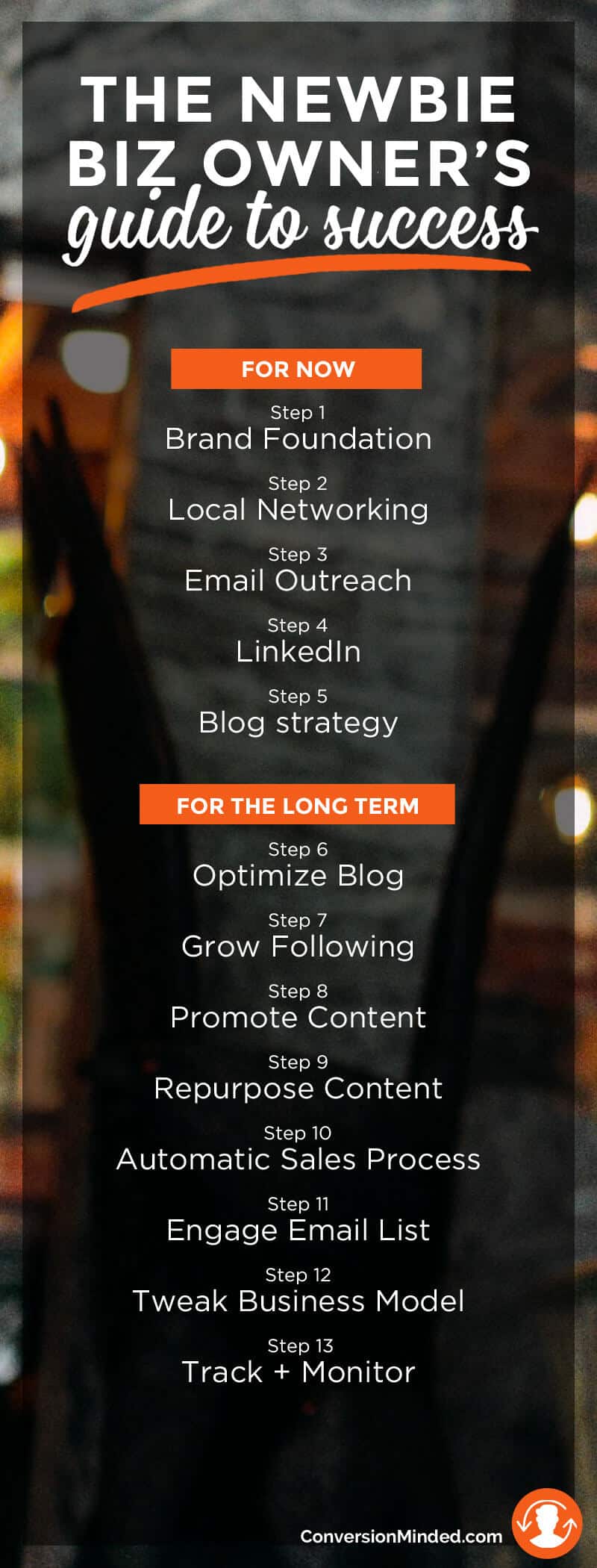The Newbie Biz Owner’s Guide to Success
This is the #1 question people ask me all the time. And I know what you’re really asking is: How can I set myself up for long term success with my business?
Before I get to the answer, everyone’s business is different, and how you market yours will depend on things like:
- Your industry
- Your business model (product vs service, online vs local)
- Your budget + resources (4-person team vs solopreneur)
Having said that, there’s no line in the sand when it comes to marketing. Whether you’re just starting out or have been in business for a while, some or all of your marketing today will be done online.
And even when you’ve been at it for years, things in your business today probably look much different than yesterday (maybe it’s time to branch out into a new market or launch a new product?).
There’s just no one-size-fits-all with marketing. How you market an online business looks different than a local business, how you market a restaurant is different than how you market a construction company, and how you market a web design company is different than how you market a retail or ecommerce business. Each one requires a slightly different strategy.
Related: 100+ Ways to Market Your Business on a Small Budget
So, back to the question How do you set your business up for long-term success?
Here’s what I think: you need a two-phase plan.
Phase one: for the now
Phase two: for the long term
This two-phase idea is from Amy Porterfield and I love it because it makes things so clear. You need a strategy to get business today and you need a long term strategy for growth.
I was so inspired by the concept of the phases that I flipped open my laptop and started writing! So in this post I’m sharing what I’ve learned over the years. Phase one includes tactics to set yourself up for success in phase two, plus gives you the quick wins and cash flow you need today:
PHASE ONE
1) Lay a solid brand foundation
Marketing really starts with a strong brand position, so this is the best place to start. Identify your “One Thing”: the one person that reflects your highly profitable customer; the one problem they have; the one solution you provide; your one offer that packages up your solution.
Use that to create a buyer persona (aka customer avatar). Dive into their goals, aspirations, and challenges, and really what you’re going for is to get inside their conversations, so that you can start hitting them with the conversations they’re already having and become the go-to for their solution. This is the basis of your future marketing.
2) Local networking
Nothing beats face-to-face marketing, even though your reach will be smaller than online. Offer to speak to local businesses, organizations and professional groups relevant to your niche. It’s also a great way to get started with webinars. You can turn those successful presentations into online events pretty easily.
3) Direct outreach via email
You can get some pretty quick wins by sending emails to prospects. Create a list of about 200 people you want to target and then create a 5- to 6-part email sequence. Make sure a few of your emails share content and resources, and a few of them request a call. You can pretty easily automate this whole process once you have a workflow down.
Pro tip: Always include a question at the end of your email so people feel like they need to respond.
4) LinkedIn
I know everyone’s all about Facebook, but I have a little love for LinkedIn because I’ve gotten great business through it. When you don’t have a mailing list (or even if you do), it can really be a goldmine of contacts. It’s basically a huge database of C-level professionals who keep their profiles current, which means you don’t have to worry about the info being outdated or incorrect.
Here’s what you do. Optimize your profile, especially your headline and Summary. Then use your customer avatar to create a Prospect Profile. Start sending sending out connection requests to people who match your criteria. Since you’re reaching out to people who don’t know you, they will first glance at your profile before accepting, which is why you want to make sure your summary is compelling.
For tips on how to optimize your LinkedIn Profile, check out this post.
5) Blog & content strategy
Okay, here’s where you start laying the groundwork for phase 2. You need a strategy for content so that you don’t spin your wheels with blogging.
With your one person in mind, create an editorial calendar around those conversations and challenges they’re having. Try to work with one theme at a time, so that you can pull 3 or 4 of your posts into an ebook or slideshare later on. Writing in themes also helps brand your content because you can create a journey for your readers (almost like a free course).
A lot of people ask about blogging frequency. Don’t worry about it. It’s much better to blog regularly, even if it’s one per month, and really provide value with each post. The better and longer your content, the more opportunity you have to hit some keywords and the more shares you’ll get.
Pro tip: an easy way to get started with themes is to answer common questions that people have.

Phase two
6) Supercharge your blog
So now you’re blogging and you’ve got a few posts under your belt. Great! It’s time to keep it going and get people (and search engines) to find it.
Basically, what you want to do is write long, information-packed posts (some people call this “epic content”) that contain important terms people would use to find you on Google. If you’re not sure where to start with this, try using BuzzSumo to find content that’s really popular, then write something similar, only better.
Install Google Analytics on your site and pay attention to which posts are getting the most views. Then extend on these with future posts. You can also take the themes you started in phase one and interlink them so that each post links to the other.
End each post with a question to encourage comments, and then respond to readers’ comments to show them that you care about their opinions and to encourage them to interact. Add share buttons to the end of your post (and also to your images) so that people can easily share your post.
I know this part is a lot to digest! I go into a lot more detail on each of these steps here.
7) Grow your following
Figure out which social platforms you’re going to dig into and start building a following.
Wherever your one person is, that’s where you want to be. Focus your time and energy on developing a following on just one or two sites. Otherwise you’ll spread yourself too thin. Share other people’s content along with your original content while you’re building up your blog. Determine the best posting frequency for each site and then automate scheduling and posting. Feedly, IFTT and Buffer are great for scheduling other people’s content and Hootsuite and Meet Edgar are great for scheduling original content.
If Pinterest and Instagram are important to you, try Tailwind or BoardBooster. And if you’re on a budget or just don’t want to pay monthly fees, here’s a free way to schedule posts to Twitter and Facebook using IFTTT and Google Calendar.
Related: 14 Ways to Get Massive Traffic From Pinterest
8) Promote your content
Now that your content strategy is in place, your blog is up and running, and you’re building a following, it’s time to really promote your content.
Create a commentary that poses a question and then Pin it, share it on Google+, Facebook, Facebook Groups, LinkedIn, and on LinkedIn Groups. Then tweet it a few times throughout the day. Also share it on Reddit, Digg, Delicious, Tumblr, BizSugar, ViralWoot, Triberr, Ping the Blog, and Instagram.
Re-share it throughout the day and then schedule more shares a few weeks later. You can also create a Facebook ad to drive traffic to it. I recommend FB ads only for your optimized posts so you can capture leads, which brings me to:
9) Optimize & repurpose content
Take popular posts from your Analytics report and turn them into downloadable ebooks, workbooks or templates. Add them to your post as a “content upgrade” (this is an easy way to start building your list). Then create landing pages for them and advertise on Facebook. LinkedIn ads are certainly worth a try, but I can’t speak to them as I’ve found Facebook works well for B2B.
You can also repackage your post to reach even more people by turning it into a video and uploading it to Facebook, or maybe turn it into a podcast. This will give you more opportunities for people to share and more links pointing back to your post. Or turn it into a webinar with a call to action at the end and advertise that on Facebook.
10) Automated sales process
Automation is what’s going to help you turn leads into customers behind the scenes so you can focus on doing everything else you need to do to run your business. This is essentially the same as the email sequences I mentioned in phase one, only you’re using different tools and targeting subscribers and people who have opted in, so they’re warm leads rather than cold leads.
When someone opts-in to your ebook, or signs up for your newsletter or webinar, you create a sequence that basically deepens the relationship and extends the conversation around the topic. Generally toward the end of the sequence you’d include a call to action. You can combine this with a sales call if you added a phone number in your opt-in form. You can use standard email marketing providers to set this up. Mailchimp, Mad Mimi, Infusionsoft, Aweber are all good ones to try.
11) Use your list
Every time you publish a new post, let your subscribers know about it. Also keep them updated on new offers and specials. Create a private page on your website with a video filled with exclusive tips just for them. Engage with them and ask them questions to find out more about their needs. This way you’ll stay top of mind, plus you can use the feedback to shape future products.
12) Tweak your business model
It’s a good idea to start tweaking your business model at this point. You want to make sure that you have content, offers and packages that move people through the entire sales cycle and give them an easy way to get to know, like and trust you, and then try your product or services before purchasing.
Think about refining your business model to include low-tier, mid-range and top-tier or VIP packages.
13) Track and monitor
I’ve found the best way to monitor is to start with an end goal, but it needs to be specific.
You want to track how much time and money you spent to acquire a customer. Here’s what I mean:
- How many prospects does it take to land one customer – how many connections, how many messages, how many hours each day?
- How many posts – which topics get the most traffic, and how long did they take you to write?
- Which combination of ad spend and offers/upsells yields a breakeven? What about a profit?
- How many times do you have to hold the webinar to reach your sales goals, and then of course, what tweaks can you make to your ad/landing page/sales pitch to get that number up?
- More metrics like this, you get the idea…








Leave a Reply
Want to join the discussion?Feel free to contribute!